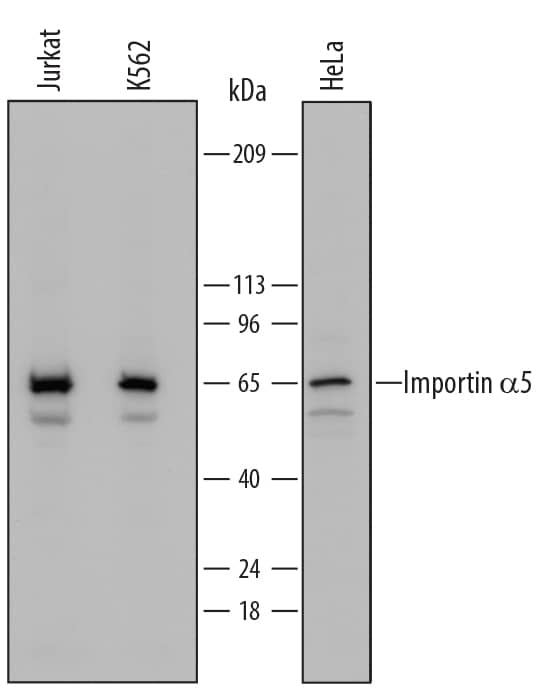Human Importin alpha5/KPNA1 Antibody
R&D Systems, part of Bio-Techne | Catalog # AF6206

Key Product Details
Species Reactivity
Applications
Label
Antibody Source
Product Specifications
Immunogen
Met1-Val132
Accession # P52294
Specificity
Clonality
Host
Isotype
Scientific Data Images for Human Importin alpha5/KPNA1 Antibody
Detection of Human Importin alpha5/KPNA1 by Western Blot.
Western blot shows lysates of Jurkat human acute T cell leukemia cell line, K562 human chronic myelogenous leukemia cell line, and HeLa human cervical epithelial carcinoma cell line. PVDF Membrane was probed with 1 µg/mL of Sheep Anti-Human Importin a5/KPNA1 Antigen Affinity-purified Polyclonal Antibody (Catalog # AF6206) followed by HRP-conjugated Anti-Sheep IgG Secondary Antibody (Catalog # HAF016). A specific band was detected for Importin a5/KPNA1 at approximately 65 kDa (as indicated). This experiment was conducted under reducing conditions and using Immunoblot Buffer Group 1.Applications for Human Importin alpha5/KPNA1 Antibody
Western Blot
Sample: Jurkat human acute T cell leukemia cell line, K562 human chronic myelogenous leukemia cell line, and HeLa human cervical epithelial carcinoma cell line
Formulation, Preparation, and Storage
Purification
Reconstitution
Formulation
Shipping
Stability & Storage
- 12 months from date of receipt, -20 to -70 °C as supplied.
- 1 month, 2 to 8 °C under sterile conditions after reconstitution.
- 6 months, -20 to -70 °C under sterile conditions after reconstitution.
Background: Importin alpha 5/KPNA1
Importin subunit alpha-5 (KPNA1, Karyopherin subunit alpha 1; also SRP1 beta, NPI-1 and RAG2) is a 65 kDa member of the importin alpha family of proteins. It is ubiquitously expressed, and found in both nucleus and cytoplasm. KPNA1 functions as a cargo carrier that transports various complexes from cytoplasm into nucleus. Two scenarios are possible. First, NLS‑containing cargo molecules bind to KPNA1, which then binds to importin beta; alternatively, KPNA1 and importin beta initially form a complex that primes KPNA1 for subsequent cargo binding. In either case, importin beta binds to the nuclear pore, facilitating transport into the nucleus. Human KPNA1 is 538 amino acids (aa) in length. It contains an N-terminal IBB/importin beta domain (aa 1‑57), ten Armadillo repeats that bind "cargo" (aa 77‑504) and two intervening NLS binding sites. Over aa 1-132, human KPNA1 shares 97% aa identity with mouse KPNA1.
Alternate Names
Gene Symbol
UniProt
Additional Importin alpha 5/KPNA1 Products
Product Documents for Human Importin alpha5/KPNA1 Antibody
Product Specific Notices for Human Importin alpha5/KPNA1 Antibody
For research use only
